Key Senate Vote on the Reliable Replacement Warhead Coming Up
On 6 June, the House Appropriations Committee eliminated funding for the Reliable Replacement Warhead [RRW] requested by the administration. [In an earlier blog entry, I discuss why the Reliable Replacement Warhead is a misnomer.] The report language is quite damning. I believe that the nuclear policy of the United States since the end of the Cold War has been, to put it charitably, absent-minded, programs have been sustained more by momentum than careful analysis. The House report recognizes that, almost two decades after the end of the Cold War, the United States does not have a plausible nuclear strategy and essentially puts a freeze on long-term spending until we develop one.
(more…)
The Stockpile Stewardship Program: Fifteen Years On
Nuclear weapons, while simple in principle, are technically complex devices with a multitude of components. As with any complicated piece of equipment, there may be concern that, over time, a weapon’s reliability could decline. To coordinate efforts to maintain the nation’s existing nuclear weapons, the Department of Energy developed a Stockpile Stewardship Program (SSP). A recently released Federation of American Scientists Occasional Paper, The Stockpile Stewardship Program: Fifteen Years On (PDF), by FAS analysts Anne Fitzpatrick and Ivan Oelrich, reviews the status of the experimental devices that support the SSP, describes how each experiment is supposed to work, and identifies the problems that have been encountered.
All of the expensive SSP experiments were initiated because of the cessation of nuclear testing, with the expectation that they would be essential to maintaining the nuclear stockpile. The major components of SSP are all seriously over budget and seriously behind schedule but, even so, our scientists now have a much better understanding of nuclear weapons and how they age. Now the DOE is proposing moving away from indefinite stockpile stewardship to a “Reliable, Replacement Warhead,” which, if designed for simplicity and with broad performance margins, could avoid the need for the SSP experiments. It is fair then to ask just how essential these megaprojects continue to be.
The SSP supported three major experiments: the National Ignition Facility (NIF) to use laser beams to compress a hydrogen target to densities and pressures where fusion would occur; the Dual-Axis Radiographic Hydrodynamic Test (DARHT) Facility uses x-rays to follow the shape of sections of plutonium when they are compressed as they would be in a nuclear bomb; and the Accelerated Strategic Computing Initiative (ASCI)—renamed Advanced Simulation and Computing (ASC) — to build supercomputers and associated software to use the information from other experiments to model nuclear warheads and predict their behavior. Two other experiments later fell under the SSP: The Joint Actinide Shock Physics Experimental Research (JASPER) facility is a high speed gun used to study shock waves in plutonium and the Z-Machine, or Z-Accelerator, creates the x-ray intensity used to study nuclear explosive conditions.
The National Ignition Facility (NIF) was originally budgeted to cost just a shade over one billion dollars and to be finished four years ago. It is now expected to carry out its first experiments in 2010 and to cost more than another billion dollars to complete, greater than the original estimates of total cost. Based on unclassified sources, it appears that the connection between NIF and the current SSP is at best indirect. We believe that NIF could be ended without reducing the confidence in the existing nuclear stockpile.
The Dual-Axis Radiographic Hydrodynamic Test (DARHT) Facility is designed to have two, hence “dual-axis,” x-ray machines that look at a subcritical plutonium pit as it is compressed by conventional explosives. Only one axis is currently operating and is providing valuable information.
The computer effort, ASC, has also been plagued with problems but is different from the two big physics experiments because it never had a focus on one particular machine. Indeed, it is not at all clear when the ASC program will be “done.” Being able to model a nuclear weapon on a computer is one of the critical substitutes for nuclear testing. The Advanced Simulation and Computing (ASC) program has already made important contributions to understanding the behavior of nuclear weapons and reportedly has resolved some worrying questions.
The ASC initiative has supported the construction of several large supercomputers. To achieve the necessary speeds, thousands of central processing units, CPUs, have been linked together to operate in parallel. These ambitious development programs have all had problems. Construction on some computers was started but never completed while some computers suffered from low reliability because of their complexity. In many cases, Herculean hardware developments were not matched by development of software that could fully exploit the new machines’ capability. Even successes were short lived: the world’s fastest computer today will be overtaken by some rival within months or a year.
To the greatest extent possible, DOE should use new computer capability coming out of industry and the universities and focus its efforts on DOE-specific problems, and get a better balance between hardware and software. DOE must justify why it needs leading edge computers when that edge is inevitably overtaken within a year or two. A decade into the SSP, DOE knows that nuclear weapons are far more stable than initially feared, and our understanding of the aging and stability of nuclear weapons continues to increase. There can and should be less urgency to DOE computer development.
All of the SSP experiments, but NIF in particular, are promoted as a means to attract top new scientific talent to DOE and the SSP. FAS remains deeply skeptical. The universities and industry are now at the cutting edge of scientific and technical advance. Anecdotal evidence strongly suggests that newly minted scientists do not look to the DOE labs as their first choice for doing pioneering research. Yet even if NIF did contribute to this goal to some degree, it is far from being the most efficient means of applying those billions of dollars. The great majority of the resources going to NIF support engineering problems—related to lasers, clean rooms, and power supplies—that have nothing whatsoever to do with either nuclear weapons or basic physics. That money could have gone directly to support university research of interest to DOE or to create smaller but scientifically more interesting experiments within the labs.
The current approach to stockpile stewardship, careful surveillance and monitoring along with judicious replacement of parts, has maintained a nuclear stockpile that is safe and reliable. Of the three major experiments supported by SSP, ASC and DARHT are already making contributions. NIF is more uncertain, both its ultimate success and its contribution to our confidence in the stockpile. But even without NIF, the United States can maintain its existing nuclear weapons without a return to testing.
FAS Nuclear Weapon Stockpile Stewardship Report Released
Nuclear weapons, while simple in principle, are technically complex devices with a multitude of components. As with any complicated piece of equipment, there may be concern that, over time, a weapon’s reliability could decline. To coordinate efforts to maintain the nation’s existing nuclear weapons, the Department of Energy developed a Stockpile Stewardship Program (SSP). A recently released Federation of American Scientists Occasional Paper, The Stockpile Stewardship Program: Fifteen Years On (PDF), by FAS analysts Anne Fitzpatrick and Ivan Oelrich, reviews the status of the experimental devices that support the SSP, describes how each experiment is supposed to work, and identifies the problems that have been encountered.
Pentagon China Report Ignores Five SSBNs Projection
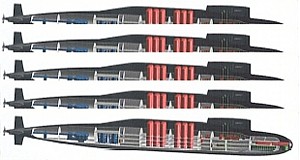 |
|
How many SSBNs are China building? |
The Pentagon’s new annual report on Chinese military power ignores a recent projection made by the Office of Naval Intelligence that China may be building five new ballistic missile submarines. The projection has since become a public “fact” after being spread around the world by news papers and private web sites.
Several news papers said earlier today – after the DOD report was leaked to them – that it identified the five Jin-class (Type 094) nuclear ballistic missile submarines. One senior defense official even was quoted saying that when the Chinese “develop five vessels like this, they are making a statement.”
Yet the DOD report does not say that China is building five SSBNs. In fact, it doesn’t give any number projection whatsoever. Instead, it repeats the projection from last year’s report that the first new SSBN may become operational sometime before the end of the decade.
So What Did Naval Intelligence Say?
When the news media first reported in March that the Office of Naval Intelligence (ONI) said China is building five Jin-class SSBNs, I requested the ONI report under the Freedom of Information Act. It is always good to check the primary source. The released report consists of answers to eight questions from Seapower Magazine about the Chinese submarine force.
Although some news media described the ONI report as saying China is building five SSBNs, ONI’s language was more vague, saying that “a fleet of probably five TYPE 094 SSBNs will be built in order to provide more redundancy and capacity for a near-continuous at-sea SSBN presence.” To me this language suggested that ONI was making a projection. So I asked ONI if it could clarify whether the number five was an assumption or a fact. In other words, does ONI know that five SSBNs are under construction (or ordered), or was the sentence a projection for what China would have to build if it wanted to have a near-continuous SSBN presence at sea?
The response was: “ONI can neither confirm or [sic] deny that ‘five’ is an actual number.”
Now that’s bureaucracy! If China is building five SSBNs, and ONI’s declassified letter to Seapower Magazine says that five are under construction, why can’t ONI confirm that five are under construction?
So I sent the declassified ONI letter to the Chinese Embassy and asked if they could confirm or deny. Here is what ONI and the media say. Are you building five SSBNs or not? Sorry, came the reply, even if we wanted to help you, no one here even knows the answer to your question.
I guess lack of transparency is a problem on both sides of the Pacific.
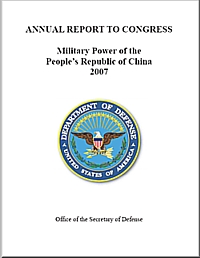
What the DOD Report Says
Perhaps there is disagreement within the intelligence community about the Chinese SSBN program. Perhaps DOD wanted to tone down the report and decided to remove ONI’s number from the final version. ONI said that
“a TYPE 094″ could reach Initial Operating [sic] Capability (IOC) as early as 2008,” but the submarine reaching IOC is not necessarily the same as the weapon system (including the JL-2) becoming operational. The DOD report limits itself to predicting that China’s strategic nuclear forces by 2010 likely include the JL-2.
In stark contrast with previous annual reports, the new report doesn’t highlight cases of dramatic Chinse submarine operations. Earlier this year I reported that Chinese submarines actually don’t sail on very many patrols; The single Xia SSBN not at all. The new DOD report does mention the Song-class submarine that “broached the surface in close proximity” to the U.S. aircraft carrier USS Kitty Hawk in October 2006 “in waters near Japan.” But rather than using the incident to warn about Chinese submarines pushing further and further into the Pacific, DOD uses it to talk about safety, saying it “demonstrated the importance of long-standing U.S. efforts to improve the safety of U.S. and Chinese military air and maritime assets operating near each other.”
DF-31 (Almost) Operational
Another “almost operational” new weapons system is the long-awaited DF-31, which finally has achieved what the DOD report calls “initial threat availability.” This allegedly occurred in 2006 after more than 20 years in development. DF-31 was first test flown in 1999 and most recently in September 2006. Actual operational capability will likely be achieved in the near future, if it has not already happened, the report states. The DF-31 will probably replace the DF-4 and likely be used for regional targeting against Guam, India and Russia.
DF-31A Operational in 2007?
A surprising prediction in the DOD report is that the longer-range version of the DF-31 – the DF-31A – may achieve IOC in 2007. This is surprising because there are no authoritative public reports, to my knowledge, that the DF-31A has yet been flight tested. The world has yet to see a picture – even a drawing – of the DF-31A. The missile is expected to supplement and eventually replace 20 old silo-based DF-5As that have been used to target the United States and Russia since the 1980s.
After the 2006 FAS/NRDC report (p. 58) described inconsistent DOD range maps for the DF-5A, the authors of the new DOD report (p. 19) have corrected the map which now shows the DF-5A as having a greater range than the DF-31A. The inaccurate range map became an issue in 2006 because it caused many news media to errouneously report that the new DF-31A will give China the ability to target all of the United States for the first time, although China has had the capability to do so with the DF-5/A since the early 1980s.
| DOD Corrects Missile Range Map | |
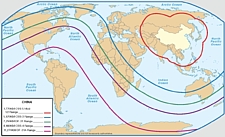 |
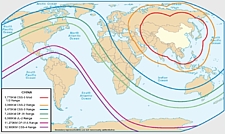 |
| The 2007 DOD report corrects the faulty missile range map from the 2006 report (left), which caused news media to write that the DF-31A would allow China to target all of the United States for the first time. The error was pointed out in the 2006 FAS/NRDC report. | |
Other Ballistic Missiles
The DOD report states that China maintains 40-50 DF-21s, an increase in the projection from the 19-23 missiles reported in 2005 and 19-50 in 2006. The reason for the changed estimate is unknown, but could be due to deployment of more conventional DF-21s. Another possibility is the DF-21’s long-awaited taking over the role of the DF-3A. It may also indicate that the “dip” in DF-21 reported by DOD in 2005 and 2006 in fact never happened.
The build-up of short-range conventional missiles continues off Taiwan, the DOD report says, with about 900 missiles had been deployed by October 2006. With a rate of about 100 missile per year, the number may have increased to approximately 950 by now. Even so, the report observes that things have been relatively quiet in the Taiwan Strait for the past two years.
The Nuclear Weapons Forecast
The DOD report does not give actual numbers for its projection of Chinese nuclear forces. It doesn’t repeat the 2001 CIA projection of 75-100 warheads primarily targeted against the United States by 2015, or mention the earlier DOD projection of 60 ICBMs primarily targeted against the United States by 2010. The new DOD report only lists the types of weapons it expect will make up the Chinese strategic nuclear arsenal by 2010: DF-4, DF-5A, DF-21, DF-31, DF-31A, JL-1, JL-2 and nuclear cruise missiles.
Depending on how many of each of the older weapon types that will remain, and how many of the new types China will actually produce and deploy in the next three years, I carefully estimate that the DOD list for 2010 translates into a Chinese arsenal of some 150-200 deployed nuclear warheads. The intelligence community does not appear to think that any of the new missiles will be equipped with multiple warheads.
Chinese Nuclear Policy
The DOD report continues previous years’ assessments of Chinese nuclear policy but now concludes that China’s no-first-use nuclear policy is “ambiguous.” The reason is that Chinese “doctrinal material” includes “additional missions for China’s nuclear forces,” DOD says, such as deterrence of conventional attacks against the Chinese mainland, reinforcing China’s great power status, and increasing its freedom of action by limiting the extent to which others can coerce China. A vigorous Chinese debate about the future role of nuclear weapons, combined with the “introduction of more capable and survivable nuclear systems in greater numbers suggest Beijing may be exploring the implications of China’s evolving force structure, and the new options that force structure may provide,” DOD states.
FAS and NRDC Almost Mentioned
The DOD report describes many more interesting statements than can be mentioned here, but one is a vague reference to the work FAS and NRDC did in 2006 where we analyzed commercial satellite photos of Chinese military facilities, including the nuclear submarine base at Jianggezhuang. In response to this (and several other cases), the DOD report describes, Chinese authorities warned that “foreigners who illegally survey, gather and publish geographical information on China will be severely punished.” DOD’s assessment of this series of events is that it “may indicate that China is attempting to lay the groundwork to extend the concept of the ‘information blockade’ into space.” Watch out DigitalGlobe; your QuickBird satellite may be next.
Background: Chinese Nuclear Forces and US Nuclear War Planning | Chinese Nuclear Forces Guide | Office of Naval Intelligence Letter
Article: Pakistani Nuclear Forces, 2007
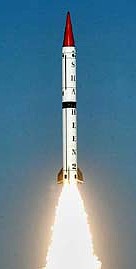 |
|
Shaheen 2 launch |
By Hans M. Kristensen
Pakistan is preparing its next-generation of nuclear-capable ballistic missile for deployment. A satellite image taken on June 5, 2005, shows what appears to be 15 Transporter Erector Launchers (TELs) for the medium-range Shaheen 2 fitting out at the National Defense Complex near Fatehjang approximately 30 kilometers southwest of Islamabad.
The vehicles were discovered as part of preparations for the latest Nuclear Notebook on Pakistani nuclear forces published in the May/June issue of the Bulletin of the Atomic Scientists. The Notebook is written by Hans M. Kristensen of the Federation of American Scientists and Robert S. Norris of the Natural Resources Defense Council.
The authors estimate that Pakistan currently has an arsenal of about 60 nuclear weapons. In the last five and a half years, Pakistan has deployed two new nuclear-capable ballistic missiles, entered the final development stages of a potentially nuclear-capable cruise missile, started construction of a new plutonium production reactor, and is close to completing a second chemical separation facility. As Pakistan completes development of two more nuclear-cable ballistic missiles and a cruise missile in the next few years, the nuclear arsenal will increase further.
| Pakistani government responds to blog:The government downplayed a report by an organization of American scientists that Pakistan is preparing its next generation nuclear-capable ballistic missile for deployment. “This is a speculative report which contains part fact and part fiction,” is how the spokesperson characterized the report.”Source: Dawn, “N-Capable Missiles,” May 11, 2007. |
The main driver for Pakistan’s nuclear modernization appears to be India’s nuclear build-up, although national prestige probably also is a factor. The two countries appear to be entering a new phase in their regional nuclear arms race with medium-range ballistic missiles gradually replacing aircraft as the backbone of their nuclear strike forces. In contrast to aircraft, ballistic missiles have a very short flight time and cannot be recalled once launched.
(more…)
Estimates of the US Nuclear Weapons Stockpile, 2007 and 2012
 |
Click on figure to open full fact sheet. For an updated stockpile estimate, go here.
The Bush administration announced in 2004 that it had decided to cut the nuclear weapons stockpile “nearly in half” by 2012, but has refused to disclose the actual numbers. Yet a fact sheet published by the Federation of American Scientists and Natural Resources Defense Council estimates that the stockpile will decline from approximately 9,938 warheads today to approximately 5,047 warheads by the end of 2012.
FAS and NRDC publish the fact sheet now because Congress is considering whether to approve a proposal by the administration to resume industrial production of new nuclear weapons, and because government officials have told Congress that production of new warheads will make it possible to reduce further the size of the stockpile in the future.
The fact sheet estimates are based on information collected by the authors over several decades about production, dismantlement and operation of US nuclear weapons.
(more…)
Article: Russian Nuclear Forces 2007
(Updated May 9, 2007)

At the beginning of 2007, Russia maintained approximately 5,600 operational nuclear warheads for delivery by ballistic missiles, aircraft, cruise missiles and torpedoes, according to the latest Nuclear Notebook published in the Bulletin of the Atomic Scientists. The Russian Notebook, which is written by Hans M. Kristensen of FAS and Robert S. Norris of NRDC, breaks down the Russian arsenal into roughly 3,300 warheads for delivery by strategic weapon systems and 2,300 warheads for delivery by tactical systems.
In addition to operational warheads, the Notebook estimates that Russia has a stock of roughly 9,400 warheads intended as a reserve or awaiting dismantlement, for a total stockpile of approximately 15,000 warheads.
The Importance of Arms Control (Section below updated May 9, 2007)
Russia and the United States apparently have decided not to extend the START agreement when it expires in 2009. The demise of the treaty will effect the number of warheads deployed on Russia’s ICBMs. Russia has already announced its intention to change the warhead loading on its Topol-M ICBMs.
Had START been extended, Russia’s arsenal of deployed strategic nuclear warheads would likely have declined to approximately 2,040 warheads by 2015 and roughly 1,590 warheads by 2030.
Once the treaty expires, however, and the Topol-M is equipped with three warheads (MIRVs, Multiple Independently Targeted Reentry Vehicles), the arsenal will reach roughly 2,210 warheads in 2015. Deployment of the silo-based Topol-M apparently will finish in 2020, in which case the warhead level will fall to approximately 1,810 warheads by 2030, depending on missile production rates for the mobile version of the Topol-M (see figure below).
|
Russian Strategic Nuclear Warheads 2006-2030 |
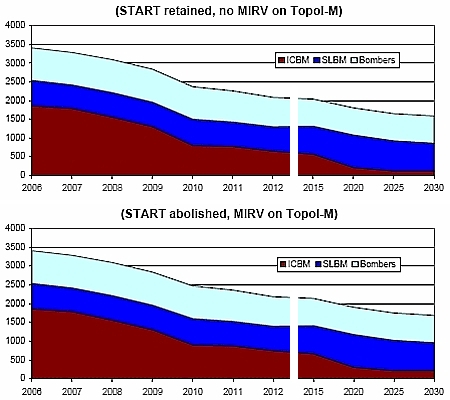 |
| The expiration of START in 2009 will have a significant impact on the future warhead level on Russia’s ICBMs. Beyond 2015, plans for the Russian force structure are uncertain. This projection a total of 84 Topol ICBMs on duty in 2015, and deployment of up to eight Borei-class SSBNs with 6 MIRVs per missile. The lower chart assumes up to 3 MIRVs on both silo and mobile Topol-M. |
Col. Gen. Nikolai Solovtsov, the commander of the Russian Strategic Rocket Forces (SRF), declared in December 2006 and again in May 2007 that Russia will begin to substitute the single warheads on Topol-M ICBMs with multiple warheads after START expires in 2009. He did not specify if that includes both the silo-based and mobile Topol-Ms. If only the silo-based Topol M is MIRVed, then Russia would have some 2,140 strategic warheads in 2015 and approximately 1,690 warheads deployed by 2030.
Current plans will leave Russia with roughly 146 ICBMs by 2015, a significant reduction from the 489 it had at the beginning of 2007, less than half of what the United States plans to have at that time. Russian planning also takes into consideration the Chinese posture, and the U.S. Air Force reported in March 2006 that work may be underway on a new strategic missile that can be deployed in both land-based and sea-based versions.
Russia apparently no longer believes it is necessary to maintain the same number of nuclear warheads as its potential adversaries, but still sees a significant strategic force as necessary. “For us,” President Vladimir Putin said in May 2006, “this idea of maintaining the strategic balance will mean that our strategic deterrence forces must be capable of destroying any potential aggressor, no matter what modern weapons systems this aggressor possesses.”
A Need For Additional Arms Control
Russia is currently, like the United States, making the decisions that will shape the long-term size and composition of its nuclear forces. Seventeen years after the Cold War ended, those decisions are still closely tied to the size and composition of the U.S. nuclear posture.
Putin proposed in June 2006 that START be replaced with a new treaty, and warned that “the stagnation we see today in the area of disarmament is of particular concern.” Although talks are underway with Washington on how to administer the strategic relationship after 2009, START apparently will not be extended.
The governments of both countries urgently need to articulate and decide on a new phase of arms control that will replace the open-ended, ad hoc nuclear planning of today with a framework for how to get to very low numbers with the medium-term goal of concluding the nuclear era.
Background: Russian Nuclear Forces 2007 | Status of World Nuclear Forces |
New US Navy Report on Chinese Navy
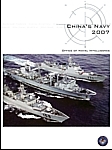
Despite frequent complains about lack of transparency in Chinese military planning, a new report from the Office of Naval Intelligence – recently described in the Washington Times and subsequently released to the Federation of American Scientists in response to a Freedom of Information Act request – boasts a high degree of knowledge about meticulous details of the Chinese navy’s operations, training, personnel and regulations.
The details in the report China’s Navy 2007 are many but unfortunately largely superfluous to the main answers many want to hear from the Office of Naval Intelligence (ONI) and other intelligence agencies: How are Chinese naval forces and operations evolving, and what do the changes mean?
Questionable Reporting
Unfortunately, some have already (mis)used the ONI report to hype fear that China is rising and out to get us. One example is the Washington Times, which last week described the report findings in a highly selective manner. Despite many unknowns about China’s military modernization and intentions, the paper’s description only included excerpts that indicate a threat or worrisome development. Moreover, the paper appears to have distorted the ONI report’s description of the Chinese submarine force’s importance: “China’s submarine forces are given ‘first priority’ of all branches of the navy, it states.”
But that’s not what the ONI report states. In fact, “first priority” as quoted by the Washington Times does not appear in the report at all. What the report says is very different: “The PLA Navy’s submarine forces…are generally listed as first in protocol order among the PLAN’s five branches.”
Being listed first in the protocol order is not the same as being the “first priority” of all the navy branches. According to the RAND Cooperation’s reference book The People’s Liberation Army as Organization:
| “PROTOCOL ORDER IN THE PLA: The PLA [People’s Liberation Army] is a very protocol oriented institution. When the PLA lists its military regions, services, service branches, administrative organizations, or its key personnel, the lists are almost always in protocol order, what the PLA calls organizational order (zuzhi xulie). The first criterion is generally the date a particular organization was established. For example, the order of the three services (junzhong) is always Army (August 1927), Navy (April 1949), and Air Force (November 1949). Since the Second Artillery Corps (July 1966) is technically a branch/service arm (bingzhong), and is usually not listed with the services….Therefore, the protocol order is more of an administrative tool today rather than a reflection of priority within the hierarchy.” (Emphasis added) |
What the ONI Report Does (and Doesn’t) Say
In contrast with the threat-focused style of the Washington Times reporting, the ONI report purports to have a much broader objective to “better understand the world’s fastest growing maritime power and its means of naval action and thereby foster a better understanding of China’s Navy.” The report observes up front that the enhanced naval power sought by China “is meant to answer global changes in the nature of warfare and domestic concerns about continued economic prosperity.” The drive to build a military component to protect the means of economic development, ONI states, “is one of the most prevalent historical reasons for building a blue water naval capability.”
Part of what has triggered the Chinese modernization is the extraordinary military capabilities that the United States have developed and deployed and demonstrated over the past two decades. The point is not that the United States is to blame and China just an innocent victim, but that all military modernization influences potential adversaries.
To that end the most interesting aspect about the ONI report may not be so much what it says but what it leaves out. Missing are many of the key developments that most concern US military planners and lawmakers, and many of the developments that are ignored by those who hype the Chinese “threat.”
For example, the ONI report does not include new information about the size of the Chinese navy. Instead it reprints a brief overview from the 2006 DOD report Military Power of the People’s Republic of China. Nor does the ONI report describe the construction of several new types of submarines, including the Type 093 nuclear-powered attack submarine and the Type 094 ballistic missile submarine.
Likewise, the ONI report begins with reprinting portions of two Chinese government documents, one of which states that the Chinese navy’s “capability of nuclear counter-attacks has also been enhanced.” This refers to China’s current possession of a single Xia-class ballistic missile submarine, but the ONI leaves out any information about what that enhancement actually is.
The other Chinese government statement used describes that the Chinese navy is “enhancing its capabilities in…nuclear counterattacks.” This is a hint that China is building a new class (Type 094 or Jin-class) of ballistic missile submarines that will be equipped with the long-range Julang-2 ballistic missile. Yet the ONI report does not give any details about the status of those programs much less what they mean for the Chinese navy or Chinese intentions.
In addition, the ONI report contains a very detailed description of the various categories of training used by the Chinese submarine force, yet it doesn’t mention submarine patrols with one word. The omission is curious because the report describes that Chinese submarines in the late 1970s began conducting independent sustained operations in the Pacific, and that “long-range navigation training is an important overall type of training for submarines.” So why leave out the important fact that the number of patrols have declined since 2000 rather than increased with the acquisition of more capable submarines?
To that end, the ONI report describes how the “basic hands-on and crisis-management training for strategic-missile submarines that cannot be conducted while the submarine is navigating underwater for long periods of time must be conducted on shore.” Yet it leaves out the important piece of information that China’s missile submarine Xia has never conducted a patrol.
Apparently, too little transparency is not only a problem in the Chinese military.
Balanced Reporting
One week before the Washington Times hyped the ONI report, the nominated commander of Pacific Command, Admiral Timothy J. Keating, testified before the Senate Armed Services Committee where he dismissed alarmist reports of recent gains in Chinese submarine development.
“If the reports are fairly accurate, they are well behind us technologically. We enjoy significant advantages across the spectrum of defensive and offensive systems, in particular undersea warfare,” he said according to Taipei Times. In an interview with the paper, Keating added: “Should it become necessary for us to put our forces [in harm’s way], the development of Chinese submarines are [sic] a concern to us, but it is hardly an insurmountable concern.”
Admiral Keating’s testimony was not covered by the Washington Times.
Breaking the cycle of military modernizations that trigger military modernizations is perhaps the biggest challenge in US-Chinese relations. Balanced reporting is another.
Background: China’s Navy 2007 | China Naval Modernization | FAS/NRDC Report
Small Fuze – Big Effect

“It is not true,” British Defence Secretary Des Browne insisted during an interview with BBC radio, that a new fuze planned for British nuclear warheads and reported by the Guardian will increase their military capability. The plan to replace the fuze “was reported to the [Parliament’s] Select Committee in 2005 and is not an upgrading of the system; it is merely making sure that the system works to its maximum efficiency,” Mr. Browne says.
The minister is either being ignorant or economical with the truth. According to numerous statements made by US officials over the past decade, the very purpose of replacing the fuze is – in stark contrast to Mr. Browne’s assurance – to give the weapon improved military capabilities it did not have before.
The matter, which is controversial now because Britain is debating whether to build a new generation of nuclear-armed submarines, concerns the Mk4 reentry vehicle on Trident D5 missiles deployed on British (and US) ballistic missile submarines. The cone-shaped Mk4 contains the nuclear explosive package itself and is designed to protect it from the fierce heat created during reentry of the Earth’s atmosphere toward the target. A small fuze at the tip of the Mk4 measures the altitude and detonates the explosive package at the right “height of burst” to create the maximum pressure to ensure destruction of the target. The new fuze will increase the “maximum efficiency” significantly and give the British Trident submarines hard target kill capability for the first time.
US Statements About Enhanced Capability
Unlike the British government, US officials and agencies have been very clear that the new fuze is not merely a replacement but a significant upgrade that will give the Mk4 significant military capabilities. The Department of Energy’s Stockpile Stewardship and Management Plan from 1997 stated that the whole purpose of developing a new fuze in the first place was to “enable [the] W76 to take advantage of [the] higher accuracy of the D5 missile.”
At about the same time, the head of the US Navy’s Strategic Systems Command, Rear Admiral George P. Nanos, explained in The Submarine Review that the “capability for the [existing] Mk4…is not very impressive by today’s standards, largely because the Mk4 was never given a fuze that made it capable of placing the burst at the right height to hold other than urban industrial targets at risk.” But “with the accuracy of D5 and Mk4, just by changing the fuse in the Mk4 re-entry body, you get a significant improvement,” Admiral Nanos stated. In fact, “the Mk4, with a modified fuze and Trident II accuracy, can meet the original D5 hard target requirement.”
| Trident Mk4A Reentry Vehicle |
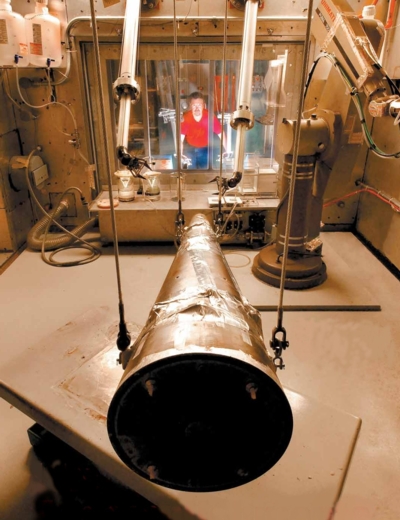 |
| The US Navy is saying – and the British government is denying – that a new fuze for the Mk4 reentry vehicle will increase the capability against hard targets. |
For US war planners, this improvement was necessary because the main US hard target killer, the MX Peacekeeper ICBMs with high-yield W87 warheads, were being retired as a result of the never-ratified 1992 START II treaty and the 2002 Moscow Treaty (SORT). The last Peacekeeper stood down in 2005. Some of the W87 are now being backfitted unto the Minuteman III ICBMs with a new guidance system to retain ICBM hard target kill capability. The Navy has a dedicated hard target kill W88 warhead on some of its D5 missiles, but with the new fuze on the W76-1/Mk4A the hard target kill capability will increase significantly. The first W76-1/Mk4A is scheduled to be delivered in September 2007.
Implications for British Deterrence
Admiral Nanos’ statement implies that British Trident submarines have never had hard target kill capability “because the Mk4 was never given a fuze that made it capable of placing the burst at the right height to hold other than urban industrial targets at risk.” With the new fuze, however, the British Trident submarines “can meet the original D5 hard target requirement,” and hold at risk the full range of targets.
So why does the British upgrade come now? After all, British nuclear submarines have cruised the oceans for decades with less capable fuzes and still ensured, so it has been said, Britain’s survival and made “significant contributions” to NATO’s deterrence.
There are several possibilities. British nuclear planners may have successfully argued that they need more accurate nuclear weapons to better deter potential adversaries. That is the dynamic the created in the Trident system during the Cold War. Since then, Britain has moved from a Soviet-focused deterrent to a “Goldilocks doctrine” today aimed against three incremental sizes of adversaries: Russia, “rogue” states, and terrorists.
Another possibility is that it may be a result of Britain not having an independent deterrent. Rather than designing and building its nuclear missiles itself, British leases them from the US missile inventory. The warhead installed on the “British” missiles is believed to be a modified – but very similar – version of the American W76. But the reentry vehicle that contains the explosive package appears to be the same: the Mk4. And since the US is upgrading its Mk4 to the Mk4A with the new fuze, Britain may simply have gotten the new capability with its existing lease.
Whatever the reason, the British government’s denial is clearly flawed. If the government believes so strongly that a nuclear deterrent is still necessary, why be so timid about its new capability? After all, what is the new capability good for if the potential adversaries can’t be told about it? And if the British government believes in the nuclear deterrent, then it has to play the deterrence role and be honest about it, and not – as it does now – pretend to be a nuclear disarmer while secretly enhancing its nuclear weapons capabilities.
US Air Force Decides to Retire Advanced Cruise Missile
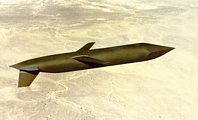
The U.S. Air Force has decided to retire the Advanced Cruise Missile, the most modern and capable nuclear cruise missile in the U.S. arsenal, according to information obtained by the Federation of American Scientists.
The decision affects approximately 400 ACMs (AGM-129A) currently deployed at Minot Air Force Base in North Dakota and Barksdale Air Force Base in Louisiana. Each missile carries a W80-1 warhead with a yield of 5-150 kilotons. The ACM is designed for delivery by B-52H strategic bombers.
FAS analyst Hans Kristensen noticed elimination of funding for the ACM in the Air Force’s FY2008 budget request, and a subsequent email to the Air Force confirmed the decision to retire the weapon system. The Air Force has not announced when the retirement will be completed, but it appears to be within the next year.
The decision to retire the ACM is part of the reduction of strategic nuclear warheads under the 2002 SORT agreement (Moscow Treaty), which limits U.S. and Russian operationally deployed strategic nuclear warheads to a maximum of 2,200 by 2012. To meet the treaty limit, the United States already has reduced the number of nuclear warheads on sea-launched ballistic missiles and is in the middle of a download of warheads from land-based ballistic missiles. Confirmation of the ACM retirement is the first public statement about a reduction of warheads on the bomber force.
The ACM is one of two nuclear cruise missiles in the U.S. arsenal, but the only nuclear cruise missile built with stealth technology to evade radar detection. The ACM, which has hard target kill capability, was produced by General Dynamics between 1987 and 1993. The initial plan was to produced nearly 1,500 missiles but the program was cut back to 460 missiles in 1991. The Air Force has not decided what to do with the retired ACM airframes, but is exploring alternative uses such as converting them to carry conventional warheads or use in missile tests.
The Air Force also has an inventory of approximately 1,300 older Air Launched Cruise Missiles (AGM-86B), which also carry the 80-1 warhead. The Air Launched Cruise Missile (ALCM) has just completed a life-extension program, and funding continues through 2013. It is estimated that the ALCM force will be reduced by two-thirds over the next five years.
The United States currently has total stockpile of nearly 9,900 nuclear warheads, of which roughly 4,700 are operationally deployed. Approximately 2,000 warheads are in the Responsive Force, a reserve of extra warheads available to increase the operational force if necessary. The remaining 3,000 warheads are scheduled to be dismantled. After the reductions under the SORT agreement are completed in 2012, the United States will still have a nuclear stockpile of nearly 6,000 warheads.
Background: Status of World Nuclear Forces
Divine Strake Experiment Canceled
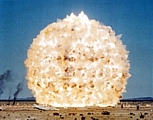 The Defense Threat Reduction Agency announced today that it has canceled the controversial Divine Strake experiment.
The Defense Threat Reduction Agency announced today that it has canceled the controversial Divine Strake experiment.
A 700 tons chemical explosion at the Nevada Test Site was intended to provide data for calibration of nuclear and conventional weapons against underground targets. Local fear that the explosion would kick up and disperse radioactive material from the ground – as well concern about Divine Strake’s role in calibrating the use of low-yield nuclear weapons against underground targets – prompted members of Congress to raise questions about Divine Strake.
The Federation of American Scientists was the first to obtain and publish confirmation from DTRA that Divine Strake was the same experiment described in the FY2006 and FY2007 DTRA budget requests as intended to “improve the warfighter’s confidence in selecting the smallest proper nuclear yield necessary to destroy underground facilities while minimizing collateral damage.” DTRA public affairs officials subsequently denied Divine Strake had any connection to nuclear missions, but were later contradicted by senior DTRA officials saying that it was nuclear related.
Background: Divine Strake
China’s Submarine Fleet Continues Low Patrol Rate

China’s entire submarine fleet conducted only two patrols in 2006, according to information declassified by the U.S. Navy and obtained by the Federation of American Scientists under the Freedom of Information Act. The low patrol rate follows a drop from an all-time high of only six patrols in 2000 to none in 2005. China’s single sea-launched ballistic missile submarine Xia, the data shows, has never conducted a deterrent patrol.
The low level of Chinese submarine patrols is a curious contrast to warnings by the Pentagon, some private institutes and news media that China is expanding its submarine operations deeper into the Pacific. Although Chinese submarines occasionally venture into the waters around Japan and Taiwan, the fleet is surprisingly inactive.
Since 1981, the first year for which patrol data is available, the Chinese submarine force has conducted an average of less than two patrols per year. The highest number of annual patrols conducted since 1981 was six patrols in 2000. In four years (1982, 1990, 1993 and 2005), no patrols were conducted at all. Over the 25-year period, the trend is that patrols have only increased from one per year to approximately 2.8 patrols per year.
|
Chinese Submarine Patrols |
 |
| The entire Chinese submarine fleet conducts less than three patrols per year on average. The ballistic missile submarine Xia has never conducted a deterrent patrol. |
So What is a Patrol?
The Navy has refused to tell FAS what a “patrol” is, saying doing so “would divulge methods and sources.” So interpretation of the data comes with a great deal of uncertainty. But the Defense Department’s unclassified Dictionary of Military Terms (JP 1-02) and earlier versions provide some hints by listing the following five definitions:
* Antisubmarine patrol: The systematic and continuing investigation of an
area or along a line to detect or hamper submarines, used when the direction
of submarine movement can be established.
* Inshore patrol: A naval defense patrol operating generally within a naval
defense coastal area and comprising all elements of harbor defenses, the
coastal lookout system, patrol craft supporting bases, aircraft, and Coast
Guard stations.
* Offshore patrol: A naval defense patrol operating in the outer areas of
navigable coastal waters. It is a part of the naval local defense forces
consisting of naval ships and aircraft and operates outside those areas
assigned to the inshore patrol.
* Patrol: A detachment of ground, sea, or air forces sent out for the purpose
of gathering information or carrying out a destructive, harassing, mopping up,
or security mission.
* Submarine patrol area: A restricted area established to allow submarine
operations: a. unimpeded by the operation of, or possible attack from, friendly
forces in wartime; b. without submerged mutual interference in peacetime.
If one assumes that U.S. Naval Intelligence’s use of the term “patrol” follows the DOD’s definitions, then the declassified patrol data suggests that Chinese general purpose submarines in 2006 twice conducted investigations to detect other submarines, participated in naval defense operations in coastal or outside coastal areas, or deployed for the purpose of gathering information or harassing. That implies an almost dormant submarine fleet.
The Song Incident
One of the two patrols conducted in 2006 appears to have been the widely reported surfacing of a Song-class diesel-electric submarine near the U.S. aircraft carrier USS Kitty Hawk in the South China Sea. The news media and pundits dramatized the incident as an example of China expanding its submarine operations, the Chinese government downplayed the reports as inaccurate, and the Pentagon said the media made too much of the incident.
“The bottom line is that […] they’re deploying them further and more frequently,” Defense News quoted an expert on the Chinese Navy at the National Defense University saying. China might even have a decisive submarine surge capability in 20 years, another pundit argued. “They are building a blue-water navy,” yet another expert warned. A politician in Taiwan thought it raises questions about “whether the U.S. in losing its military edge in the Western Pacific,” and commentators in both Taipei and Washington concluded that the incident showed that Taiwan needs to buy more submarines.
The Pentagon’s 2006 report Military Power of the People’s Republic of China stated that China was working on establishing a “first” or “second island chain” strategy for its naval forces, and that “Chinese forces have increased operations beyond China’s borders and coastal waters.” This may be the case for surface ships, but to illustrate the development the Pentagon highlighted “the highly publicized 2004 intrusion of a HAN-class nuclear submarine in Japanese territorial waters during operations far into the western Pacific Ocean.” DOD did not mention that the intrusion was one of only three patrols conducted by the entire Chinese submarine force in 2004, and that no patrols at all were conducted in 2005.
The U.S.-China Commission established by Congress after reports about Chinese spying, stated in 2006 that China is pursuing measures to try to “control” the seas in the Western Pacific, although “controlling” the seas is a daunting technological and operational task, and that China continues to “expand” its submarine force.
The Shrinking Chinese Submarine Fleet
Although China is modernizing its submarine force, it is not “expanding” it. Since the mid-1980s, the force has been in steady decline from nearly 120 boats to roughly 55 operational submarines today. The U.S. Navy expects the force will level out around 40 boats in the next decade.
|
The Shrinking Chinese Submarine Fleet |
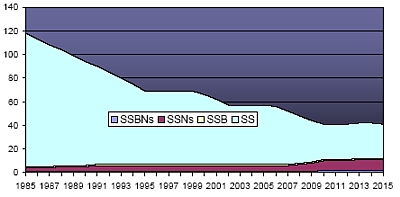 |
| The Chinese submarine fleet has declined by approximately 50 percent since the mid-1980s, mainly due to retirement of old and obsolete classes. Construction of new classes is underway but is not anticipated to lead to an increase, as the U.S. Navy expects the fleet will level out at around 40 submarines in the next decade. |
The decline of the submarine fleet is part of a transition where large older classes are being phased out and replaced with newer but less numerous submarine classes. The new submarines are more capable than the ones they replace, but the modernization has not resulted in an increase in the number of submarine patrols. On the contrary, during the period between 2000 and 2006, when China acquired a dozen new Kilo and Song class submarines, the number of patrols declined from six to two (with no patrols at all in 2005).
Implications
The implications of the low patrol rate are significant. The total operational experience for the entire Chinese submarine force is only 49 patrols in 25 years, corresponding to each submarine conducting an average of one patrol every third year.
As a result, Chinese submarine crews appear to have relatively little operational experience and consequently limited skills in operating their boats safely and competently. It suggests that the tactical skills that would be needed for the Chinese submarine force to operate effectively in a war may be limited.
China continues – at least for now – to use its submarine force as a coastal defense force.
Background: Chinese Nuclear Forces and U.S. Nuclear War Planning